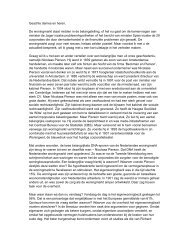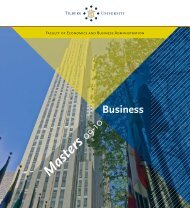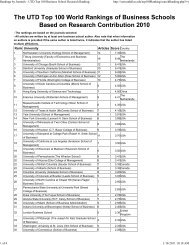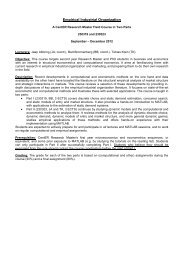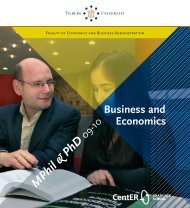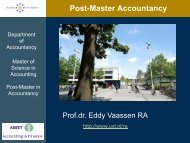Predicting the past - Tilburg University, The Netherlands
Predicting the past - Tilburg University, The Netherlands
Predicting the past - Tilburg University, The Netherlands
You also want an ePaper? Increase the reach of your titles
YUMPU automatically turns print PDFs into web optimized ePapers that Google loves.
If you are like most people, <strong>the</strong>n you would answer that <strong>the</strong> probability of obtaining more<br />
than 60% boys is about <strong>the</strong> same in each hospital. But this is not true. Sampling <strong>the</strong>ory<br />
tells us that <strong>the</strong> expected number of days on which more than 60% of <strong>the</strong> babies are<br />
boys is much greater in <strong>the</strong> small hospital than in <strong>the</strong> large one. Why? Because with more<br />
observations <strong>the</strong> precision increases and we are less likely to stray from 50%.<br />
This example is one of many where simple statistical thinking proves too difficult for <strong>the</strong><br />
majority of people. My explanation for this fact (that people find statistics particularly<br />
difficult, much more difficult than say ma<strong>the</strong>matics) has been for a long time that we are<br />
not (or hardly) exposed to statistics at school. We are exposed to ma<strong>the</strong>matics from a very<br />
young age, but not to statistics. Hence, our intuition is not developed and we make stupid<br />
errors. This was my explanation, but Daniel Kahneman has convinced me that I am wrong<br />
by presenting <strong>the</strong> following two ma<strong>the</strong>matical cases, taken from his recent book Thinking,<br />
Fast and Slow. First, this puzzle.<br />
A bat and ball cost toge<strong>the</strong>r € 1.10.<br />
<strong>The</strong> bat costs one euro more than <strong>the</strong> ball.<br />
How much does <strong>the</strong> ball cost?<br />
This is a ma<strong>the</strong>matics example, <strong>the</strong>re is no statistics in it, and a very simple one. Still,<br />
almost all of you will think that <strong>the</strong> answer is 10 cents. But it isn’t. <strong>The</strong> answer is 5 cents.<br />
<strong>The</strong> ball costs 5 cents and <strong>the</strong> bat costs € 1.05, toge<strong>the</strong>r € 1.10.<br />
Here is ano<strong>the</strong>r puzzle.<br />
All roses are flowers.<br />
Some flowers fade quickly.<br />
<strong>The</strong>refore some roses fade quickly.<br />
Is <strong>the</strong> argument correct? Most people — according to Kahneman — think it is. But it isn’t.<br />
<strong>The</strong> fact that some flowers fade quickly could mean that some roses fade quickly, but it<br />
could also mean that some flowers, <strong>the</strong> hibiscus for example, fade quickly but that roses<br />
do not fade quickly at all.<br />
So, ma<strong>the</strong>matics intuition seems not that well developed ei<strong>the</strong>r, and my own intuition<br />
about <strong>the</strong> difference between ma<strong>the</strong>matics and statistics appears to have been wrong.<br />
12 <strong>Predicting</strong> <strong>the</strong> <strong>past</strong>




